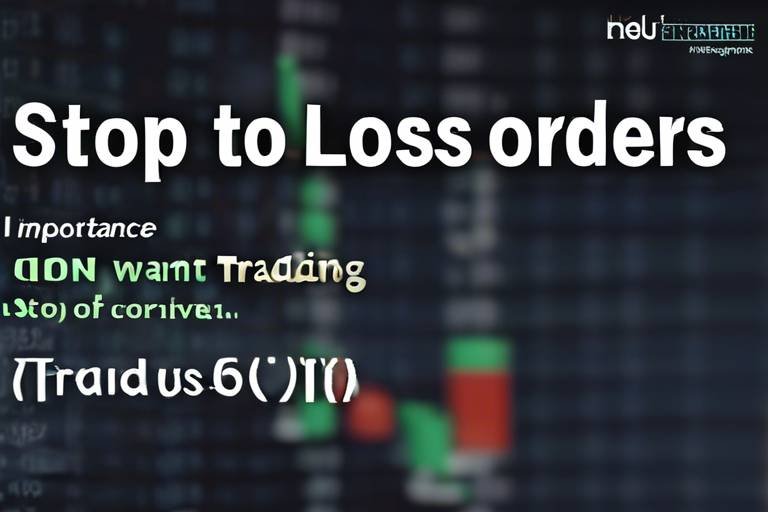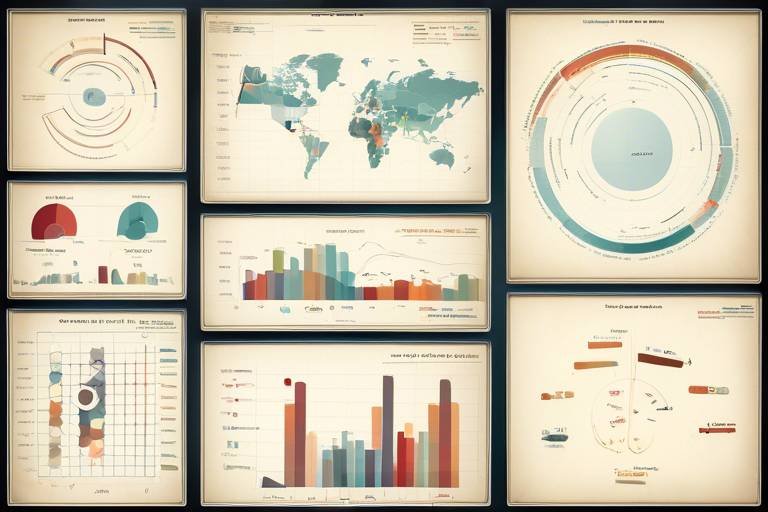How to Integrate Machine Learning into Crypto Trading
In the fast-paced world of cryptocurrency trading, where every second counts and market trends can shift dramatically, the integration of machine learning (ML) has emerged as a game-changer. Imagine having a smart assistant that not only analyzes vast amounts of data but also learns from it, adapting to market changes in real-time. This article explores the intersection of machine learning and cryptocurrency trading, detailing methods, benefits, and challenges of implementing advanced algorithms for improved trading strategies.
Understanding the fundamentals of machine learning is crucial for anyone looking to integrate it into crypto trading. At its core, machine learning is a subset of artificial intelligence that focuses on building systems that can learn from and make predictions based on data. There are several types of algorithms, including supervised learning, unsupervised learning, and reinforcement learning. Each of these plays a unique role in financial markets, enabling traders to predict price movements, identify patterns, and optimize trading strategies.
Data is the backbone of machine learning, and in the world of cryptocurrency, it’s abundant yet complex. Effective strategies for gathering and preprocessing this data are essential. Traders need to collect data from various sources, such as exchange APIs, blockchain explorers, and social media sentiment analysis. Once collected, this data must be cleaned and transformed into a usable format. This process may include removing duplicates, handling missing values, and normalizing data to ensure quality inputs for your models. For instance, consider the following table that outlines common data sources and their relevance:
| Data Source | Description |
|---|---|
| Exchange APIs | Real-time trading data, including price, volume, and order book information. |
| Blockchain Explorers | Data related to transactions, blocks, and addresses on the blockchain. |
| Social Media | Sentiment analysis from platforms like Twitter and Reddit to gauge market mood. |
Selecting the appropriate machine learning algorithms is vital for success in crypto trading. Various algorithms can be employed depending on the specific goals of the trading strategy. For example, supervised learning techniques, such as regression and classification, are great for predicting price movements based on historical data. On the other hand, unsupervised learning can help identify hidden patterns in trading data without predefined labels. It's essential to understand the strengths and weaknesses of each algorithm to make informed decisions.
Feature engineering is a crucial step that enhances model performance. By creating meaningful features from raw data, traders can significantly improve the predictive power of their machine learning models. Techniques such as time series analysis, technical indicators, and sentiment scores can be utilized to extract valuable insights. For instance, incorporating moving averages or relative strength index (RSI) as features can help models better understand market trends and make more accurate predictions.
Backtesting is essential for validating your trading strategies. By applying machine learning models to historical data, traders can assess their performance and make necessary adjustments before going live. This process involves simulating trades based on past market conditions and analyzing the outcomes. Effective backtesting not only helps in understanding how a model would have performed but also aids in identifying potential pitfalls. Remember, a model that performs well in backtesting may not always yield the same results in real-time trading.
Incorporating risk management is crucial for sustainable trading. Machine learning can help identify risks by analyzing market volatility, liquidity, and other factors that could impact trading performance. By developing strategies to mitigate these risks, traders can protect their investments and ensure long-term success. Techniques such as stop-loss orders, position sizing, and diversification can be optimized using machine learning algorithms, allowing for a more dynamic approach to risk management.
Integrating machine learning models into live trading systems requires careful planning. Traders must consider factors such as latency, execution speed, and system reliability. Best practices for deploying models in real-time trading environments include using cloud-based solutions for scalability, continuous monitoring of model performance, and implementing automated trading systems to execute trades based on model predictions. This ensures that traders can capitalize on market opportunities as they arise without delay.
The landscape of machine learning and cryptocurrency trading is constantly evolving. Emerging trends such as deep learning, reinforcement learning, and blockchain technology are set to shape the future of this integration. As algorithms become more sophisticated, traders will have access to even more powerful tools for making informed decisions. Additionally, the growing importance of regulatory compliance and data privacy will influence how machine learning is utilized in the trading space.
Q: What is machine learning in crypto trading?
A: Machine learning in crypto trading refers to the use of algorithms and statistical models to analyze data, identify patterns, and predict future price movements.
Q: How can I start using machine learning for trading?
A: Begin by learning the basics of machine learning, collecting relevant data, and experimenting with different algorithms and models to find what works best for your trading strategy.
Q: Is machine learning a guaranteed way to make money in trading?
A: While machine learning can enhance trading strategies, it is not a guaranteed way to make money. Market conditions can change rapidly, and no model can predict the future with absolute certainty.

The Basics of Machine Learning
Understanding machine learning fundamentals is crucial for integrating it into crypto trading. At its core, machine learning is a subset of artificial intelligence that enables systems to learn from data, identify patterns, and make decisions with minimal human intervention. Imagine teaching a child how to recognize different animals by showing them numerous pictures; similarly, machine learning algorithms learn from vast amounts of data to make sense of complex information.
There are several types of algorithms in machine learning, each serving different purposes and suited for various tasks. The two primary categories are supervised learning and unsupervised learning. In supervised learning, the algorithm is trained on labeled data, meaning that the input data comes with the correct output labels. This is akin to having a guide while navigating a new city. On the other hand, unsupervised learning deals with unlabeled data, where the algorithm attempts to identify patterns and groupings on its own, much like exploring a city without a map.
In the context of financial markets, and specifically in crypto trading, machine learning can analyze historical price data, trading volumes, and even social media sentiment to predict future price movements. This is where the magic happens! By leveraging big data, traders can uncover insights that might be invisible to the naked eye. For instance, a machine learning model could analyze thousands of tweets related to a cryptocurrency and correlate them with price fluctuations, helping traders make informed decisions.
Another essential aspect of machine learning is the concept of features. Features are individual measurable properties or characteristics used by the algorithm to make predictions. In crypto trading, features could include price trends, market capitalization, or even transaction volume. The better the features you use, the more accurate your predictions will be. Think of features as ingredients in a recipe; the right combination can lead to a delicious outcome, while the wrong mix can spoil the dish.
To summarize, grasping the basics of machine learning involves understanding its core principles, the types of algorithms available, and the importance of quality data and features. As the crypto trading landscape becomes increasingly competitive, integrating machine learning into trading strategies can provide a significant edge. So, if you're looking to enhance your trading game, diving into machine learning might just be the key to unlocking new opportunities.
- What is machine learning? Machine learning is a branch of artificial intelligence that enables systems to learn from data and make predictions.
- What are supervised and unsupervised learning? Supervised learning uses labeled data for training, while unsupervised learning works with unlabeled data to find patterns.
- How can machine learning benefit crypto trading? It can analyze large datasets to identify trends, predict price movements, and improve trading strategies.

Data Collection and Preparation
When it comes to machine learning in crypto trading, data is essentially the lifeblood of your models. Without high-quality data, even the most sophisticated algorithms will struggle to make accurate predictions. So, how do you go about collecting and preparing this data? First, you need to understand what kind of data is available and how it can be utilized. Cryptocurrency data typically falls into several categories: price data, volume data, social media sentiment, and blockchain data. Each type offers unique insights that can significantly impact trading strategies.
For instance, price data includes historical prices, opening and closing prices, and price volatility. This data can help identify trends and patterns that are essential for making informed trading decisions. On the other hand, volume data indicates the amount of a cryptocurrency that has been traded over a specific period. High trading volumes can signify strong market interest, while low volumes might suggest a lack of confidence in a cryptocurrency.
Next, let’s talk about the importance of data preparation. Raw data is often messy and unstructured, requiring extensive preprocessing before it can be fed into machine learning models. This process might include cleaning the data by removing duplicates, handling missing values, and normalizing the data to ensure consistency. Additionally, you might want to transform your data into a format that is more suitable for analysis. For example, converting timestamps into a more usable format or aggregating data into meaningful intervals can provide better insights.
Another crucial aspect of data preparation is feature selection. This involves identifying which variables (or features) are most relevant to your trading strategy. Not all data points are equally valuable; some may introduce noise that can confuse your model. By focusing on key features, such as moving averages or relative strength index (RSI), you can enhance the predictive power of your machine learning algorithms. Here’s a simple table that summarizes the types of data you might collect and their potential uses:
| Data Type | Description | Potential Use |
|---|---|---|
| Price Data | Historical prices of cryptocurrencies | Trend analysis and price prediction |
| Volume Data | Amount of cryptocurrency traded | Market sentiment and liquidity assessment |
| Social Media Sentiment | Public sentiment derived from social media platforms | Market mood and potential price movements |
| Blockchain Data | Transaction data from the blockchain | Network activity and security analysis |
In summary, effective data collection and preparation are pivotal for the success of machine learning in crypto trading. By gathering diverse data types and meticulously preprocessing them, you set the stage for your algorithms to thrive. Remember, the more robust your data foundation, the more reliable your trading strategies will become. As you dive deeper into the world of machine learning and cryptocurrency, keep refining your data processes—they are the key to unlocking your trading potential.
- What types of data are most useful for crypto trading? Price data, volume data, social media sentiment, and blockchain data are all crucial for informed trading decisions.
- How can I clean my data effectively? Remove duplicates, handle missing values, and normalize the data to ensure consistency.
- Why is feature selection important? It helps identify the most relevant variables for your trading strategy, enhancing the predictive power of your models.

Choosing the Right Algorithms
When it comes to integrating machine learning into crypto trading, is akin to selecting the perfect tools for a craftsman. Just as a carpenter wouldn't use a hammer to carve fine details, a trader must pick algorithms that suit their specific trading strategies and goals. The landscape of machine learning is vast, with various algorithms offering unique advantages depending on the trading context. In this section, we'll explore some popular algorithms and how they can be effectively utilized in the world of cryptocurrency trading.
First, let's talk about supervised learning algorithms. These algorithms require labeled data to train the model, meaning you need historical data that includes both the input features and the corresponding output. Think of supervised learning as a teacher guiding a student; the model learns from past examples to make predictions about future data. Common supervised learning algorithms include:
- Linear Regression: Ideal for predicting price trends based on historical data.
- Support Vector Machines (SVM): Excellent for classification tasks, such as determining whether a cryptocurrency's price will rise or fall.
- Decision Trees: Useful for making decisions based on a series of conditions, providing clear and interpretable results.
On the other hand, we have unsupervised learning algorithms, which are particularly valuable when dealing with unlabeled data. These algorithms help identify patterns and groupings within the data, much like an artist discovering forms in a block of marble. They can be incredibly useful for analyzing market sentiment or clustering similar cryptocurrencies. Some notable unsupervised learning techniques include:
- K-Means Clustering: Helps in segmenting cryptocurrencies into groups based on similarities, aiding in portfolio diversification.
- Principal Component Analysis (PCA): Reduces the dimensionality of data, making it easier to visualize and identify trends.
Moreover, reinforcement learning is an emerging approach that is gaining traction within the crypto trading community. This algorithm learns by interacting with the trading environment, receiving feedback in the form of rewards or penalties. It’s akin to teaching a dog tricks; the more the dog performs well, the more treats it gets. In trading, this can mean adjusting strategies based on market conditions, leading to potentially more adaptive and profitable trading models.
To further illustrate the differences between these algorithms, consider the following table that summarizes their key characteristics:
| Algorithm Type | Key Features | Use Cases in Crypto Trading |
|---|---|---|
| Supervised Learning | Labeled data, predictive modeling | Price prediction, trend analysis |
| Unsupervised Learning | Unlabeled data, pattern recognition | Market segmentation, anomaly detection |
| Reinforcement Learning | Interactive learning, adaptive strategies | Dynamic trading strategies, portfolio optimization |
Ultimately, the choice of algorithm should align with your specific trading goals, the nature of the data you have, and the complexity of the market conditions you wish to navigate. It’s essential to experiment with different algorithms and evaluate their performance through rigorous backtesting. Remember, the right algorithm can be the difference between a successful trading strategy and a costly mistake. So, take your time, analyze your options, and choose wisely!
Q: What is the best machine learning algorithm for crypto trading?
A: There isn't a one-size-fits-all answer. The best algorithm depends on your trading strategy, the type of data you have, and your specific goals. It's advisable to experiment with multiple algorithms to find what works best for you.
Q: Can I use machine learning without programming knowledge?
A: While basic programming skills can be helpful, there are user-friendly platforms and tools that allow you to implement machine learning models without extensive coding experience.
Q: How important is data quality in machine learning?
A: Data quality is crucial. Poor quality data can lead to inaccurate predictions and ultimately affect your trading performance. Always ensure you gather and preprocess your data effectively.

Feature Engineering Techniques
When it comes to machine learning in crypto trading, feature engineering is like the secret sauce that can make or break your model. Think of it as the process of transforming raw data into a format that makes your algorithms shine. Just like a sculptor chisels away at a block of marble to reveal a masterpiece, effective feature engineering helps you extract valuable insights from seemingly chaotic cryptocurrency data.
So, what exactly does feature engineering entail? It involves creating new features or modifying existing ones to improve the predictive power of your models. This can include a variety of techniques, such as:
- Normalization: Scaling your data to a standard range helps algorithms perform better. For instance, if one feature has values ranging from 1 to 1000 and another from 0 to 1, it can skew the model’s understanding.
- Time-Series Features: In crypto trading, time is of the essence. Creating features that capture trends over time, such as moving averages or volatility indices, can provide your model with crucial context.
- Lagged Features: These are past values of a feature that can help predict future values. For example, including the price of Bitcoin from one day ago can offer insights into its current price movements.
Now, let’s dive deeper into some advanced techniques that can elevate your feature engineering game:
1. Technical Indicators: Many traders rely on technical analysis, which uses historical price and volume data to forecast future price movements. By incorporating technical indicators like the Relative Strength Index (RSI) or Moving Average Convergence Divergence (MACD), you can provide your model with additional layers of information that reflect market sentiment.
2. Sentiment Analysis: The cryptocurrency market is heavily influenced by public sentiment, often driven by social media and news articles. By utilizing natural language processing (NLP) techniques to analyze tweets or news headlines, you can create sentiment indicators that reflect the mood of the market. This can be a game-changer when combined with traditional price data.
3. Feature Selection: Not all features are created equal. In fact, including too many irrelevant features can lead to overfitting, where your model performs well on training data but poorly on unseen data. Techniques like recursive feature elimination or using algorithms such as Lasso regression can help you identify and retain only the most impactful features.
To illustrate the importance of feature engineering, consider the following table, which compares two models—one with basic features and another enhanced with advanced engineering techniques:
| Model | Features Used | Accuracy |
|---|---|---|
| Basic Model | Price, Volume | 65% |
| Advanced Model | Price, Volume, Technical Indicators, Sentiment | 85% |
As you can see, the advanced model significantly outperforms the basic one, demonstrating how critical feature engineering is in enhancing your machine learning models. The goal is to make your features as informative as possible, which can lead to better trading decisions and improved profitability.
In conclusion, mastering feature engineering techniques is essential for anyone looking to integrate machine learning into cryptocurrency trading. By carefully selecting and crafting your features, you can unlock the full potential of your algorithms, turning raw data into actionable insights that can give you a competitive edge in the fast-paced world of crypto.
Q: What is feature engineering?
A: Feature engineering is the process of transforming raw data into meaningful features that improve the performance of machine learning models.
Q: Why is feature engineering important in crypto trading?
A: It allows traders to extract relevant insights from data, enhancing the model's predictive capability and ultimately leading to better trading decisions.
Q: What are some common feature engineering techniques?
A: Common techniques include normalization, creating time-series features, lagged features, and incorporating technical indicators.

Backtesting Models
Backtesting is a critical step in the development of any trading strategy, especially when integrating machine learning into cryptocurrency trading. It allows traders to evaluate how their models would have performed using historical data, providing insights into their effectiveness and reliability. Imagine trying to navigate a ship through uncharted waters without a map—this is what trading without backtesting feels like. By utilizing past market data, you can plot a course that maximizes your chances of success.
To effectively backtest machine learning models, you need a structured approach. First, gather historical data that reflects the market conditions you wish to analyze. This data should include price movements, volume, and other relevant indicators. The more comprehensive your dataset, the better your model can learn from it. Next, divide your data into training and testing sets. The training set is used to build your model, while the testing set evaluates its performance on unseen data. This is akin to studying for an exam: you need to practice with old tests to prepare for the real thing.
When backtesting, it’s essential to consider various metrics to assess your model's performance. Common metrics include:
- Sharpe Ratio: This measures the risk-adjusted return of your trading strategy. A higher ratio indicates better performance relative to risk.
- Maximum Drawdown: This metric highlights the largest drop from a peak to a trough in your strategy's equity curve, giving insight into potential risks.
- Win Rate: The percentage of profitable trades compared to total trades, which helps gauge the effectiveness of your strategy.
It's also crucial to implement a robust backtesting framework that can simulate trading conditions accurately. This means accounting for factors like transaction costs, slippage, and market impact. If your model performs well in a vacuum but fails to account for these real-world conditions, the results could be misleading. Think of it like testing a race car on a smooth track; the performance might be stellar, but it won’t hold up on a bumpy road.
Moreover, consider using a backtesting library or platform that allows for easy integration with your machine learning models. Popular options include Backtrader, Zipline, and QuantConnect. These platforms provide the tools necessary to streamline the backtesting process, enabling you to focus on refining your algorithms rather than getting bogged down in technical details.
Finally, always remember that past performance is not indicative of future results. While backtesting can provide valuable insights, it is not foolproof. Market conditions can change rapidly, and what worked yesterday may not work tomorrow. Therefore, it's essential to continuously monitor and adjust your models based on current market dynamics. Think of your trading strategy as a living organism; it requires constant nurturing and adaptation to thrive.
What is backtesting?
Backtesting is the process of testing a trading strategy using historical data to see how it would have performed in the past.
Why is backtesting important?
It helps traders validate their strategies, understand potential risks, and improve their models before deploying them in live trading scenarios.
What metrics should I use for backtesting?
Key metrics include Sharpe Ratio, Maximum Drawdown, and Win Rate, which provide insights into the performance and risk of your trading strategy.
Can backtesting guarantee future success?
No, while backtesting can provide valuable insights, it cannot predict future performance due to the ever-changing nature of the markets.

Risk Management Strategies
When it comes to crypto trading, the thrill of potential profits can sometimes overshadow the inherent risks involved. That's where come into play. Think of it as your safety net; without it, you might find yourself tumbling into the abyss of financial loss. So, how do you effectively manage risks while enjoying the rollercoaster of cryptocurrency trading?
First and foremost, it's essential to understand that machine learning can significantly enhance your risk management efforts. By analyzing vast amounts of data, machine learning algorithms can identify patterns and anomalies that might go unnoticed by the human eye. This predictive capability allows traders to make informed decisions, reducing the likelihood of unexpected losses.
One effective approach is to implement a stop-loss strategy. This involves setting predetermined price points at which a trade will automatically close if the market moves against you. For instance, if you purchase a cryptocurrency at $100, you might set a stop-loss order at $90. This way, if the price drops to $90, your position is closed, limiting your loss to just $10. It’s like having a parachute; it won’t stop the fall, but it will soften the landing.
Another critical aspect is diversification. Just as you wouldn't put all your eggs in one basket, you shouldn't invest all your capital in a single cryptocurrency. By spreading your investments across various digital assets, you mitigate the risk of a significant loss if one asset performs poorly. A well-diversified portfolio can help stabilize returns over time, providing a buffer against market volatility.
Moreover, utilizing portfolio optimization techniques can further enhance your risk management strategy. These techniques leverage machine learning algorithms to analyze historical data and optimize your asset allocation. By assessing the risk-return profile of various assets, you can create a balanced portfolio that aligns with your risk tolerance and investment goals.
Incorporating real-time monitoring is also essential. Machine learning models can continuously analyze market conditions and provide alerts when certain risk thresholds are met. This proactive approach allows traders to react swiftly to market changes, ensuring that they can adjust their strategies as needed. Imagine having a personal assistant who constantly watches the market for you, alerting you when it’s time to make a move.
Finally, it's crucial to regularly review and adjust your risk management strategies. The crypto market is notoriously volatile, and what worked yesterday may not work tomorrow. By continuously evaluating your approaches and adapting to new market conditions, you can maintain a robust risk management framework that evolves alongside the market.
In summary, effective risk management in crypto trading is not just about avoiding losses; it’s about creating a sustainable trading environment. By integrating machine learning, employing stop-loss orders, diversifying your portfolio, optimizing asset allocation, and continuously monitoring market conditions, you can significantly enhance your trading strategy. Remember, in the world of crypto, it’s not just about how much you can gain, but how well you can protect what you have.
- What is risk management in crypto trading? Risk management involves strategies and techniques designed to minimize potential losses while maximizing potential gains in cryptocurrency trading.
- How can machine learning improve risk management? Machine learning can analyze large datasets to identify trends and anomalies, helping traders make informed decisions and reduce risks.
- What is a stop-loss order? A stop-loss order is a predetermined price point at which a trader's position will automatically close to limit losses.
- Why is diversification important? Diversification helps mitigate risks by spreading investments across various assets, reducing the impact of poor performance in any single asset.

Real-time Implementation
Integrating machine learning models into live trading systems is a critical step that can make or break your trading strategy. Imagine you’ve spent countless hours fine-tuning your algorithms, only to find that they don’t perform well under real market conditions. This is where the rubber meets the road! To ensure a smooth transition from backtesting to real-time implementation, several factors must be considered.
First and foremost, you need to establish a robust infrastructure that can handle live data feeds and execute trades in real-time. This involves setting up a reliable server, ensuring low latency connections, and utilizing APIs that can interact with cryptocurrency exchanges effectively. Think of your infrastructure as the sturdy foundation of a house; without it, everything else can crumble.
Next, it’s crucial to monitor your models continuously. Market conditions can change rapidly, and what worked yesterday might not work today. Implementing a monitoring system that tracks the performance of your trading algorithms in real-time is essential. This system should be able to alert you to any anomalies or significant changes in performance. You wouldn’t want to drive a car without a dashboard, would you? Similarly, having insights into how your models are performing allows you to make quick adjustments as necessary.
Moreover, consider the aspect of risk management during real-time implementation. Machine learning can assist in identifying potential risks by analyzing patterns and predicting market movements. By incorporating risk management strategies, you can set stop-loss orders or dynamically adjust your trading volume based on the model's confidence level. This proactive approach can significantly minimize potential losses.
Another important point is to ensure that your trading system is compliant with the regulations of the cryptocurrency market. Different jurisdictions have varying rules regarding trading practices, and adhering to these regulations is critical to avoid legal repercussions. It’s advisable to consult with legal experts to navigate this complex landscape.
Finally, the integration of machine learning into real-time trading is not a one-time effort. It’s an ongoing process that requires continual learning and adaptation. Regularly updating your models with new data and retraining them to adapt to changing market conditions is vital. After all, the financial markets are like a flowing river; they constantly change, and your strategies must evolve with them.
- What is the main challenge in real-time implementation of machine learning in crypto trading?
The primary challenge is ensuring that the models perform as expected under live market conditions, which can differ significantly from backtested scenarios. - How can I monitor my machine learning models effectively?
Implement a monitoring system that tracks performance metrics and alerts you to any anomalies in real-time. - What role does risk management play in real-time trading?
Risk management is crucial for minimizing potential losses and involves setting stop-loss orders and adjusting trading volumes based on model confidence. - Are there legal considerations for real-time crypto trading?
Yes, it’s essential to comply with local regulations regarding cryptocurrency trading to avoid legal issues.

Future Trends in ML and Crypto Trading
The world of cryptocurrency trading is like a rollercoaster ride—full of ups, downs, and unexpected twists. As we look ahead, the integration of machine learning (ML) into crypto trading is not just a trend; it's becoming a necessity. With the rapid advancements in technology, we can expect to see several exciting trends that will shape the future of this dynamic landscape. But what exactly can we anticipate?
One of the most significant trends is the growing use of automated trading systems. These systems leverage ML algorithms to analyze vast amounts of data at lightning speed, making split-second trading decisions that humans simply can't match. Imagine a robot trader that never sleeps, continuously learning from market fluctuations and adjusting its strategies in real-time. This level of automation is not just a dream; it's already being implemented in various trading platforms.
Another trend to watch is the rise of predictive analytics. As ML models become more sophisticated, they will be able to predict price movements with greater accuracy. Traders will rely on these predictions to make informed decisions, potentially increasing their profitability. For instance, using historical data and current market indicators, ML can identify patterns that may not be visible to the naked eye, allowing traders to capitalize on emerging opportunities.
Moreover, we are likely to see an increase in the use of natural language processing (NLP) within crypto trading. This technology enables machines to understand and interpret human language, which can be invaluable for analyzing social media sentiment, news articles, and other textual data that influence market trends. By gauging public sentiment, traders can make more informed decisions based on the collective mood of the market.
Additionally, the importance of data privacy and security will become paramount. As more traders and institutions adopt ML in their trading strategies, the need for secure data handling practices will grow. Blockchain technology, with its inherent security features, could play a vital role in ensuring that sensitive trading data remains protected from cyber threats.
Furthermore, the integration of decentralized finance (DeFi) with machine learning is on the horizon. DeFi platforms are already transforming the financial landscape, and when combined with ML, they could provide unprecedented levels of efficiency and transparency in trading. This synergy could lead to the development of smart contracts that automatically execute trades based on predefined ML predictions, creating a seamless trading experience.
As we embrace these trends, it's essential to consider the ethical implications of using ML in crypto trading. The potential for algorithmic bias and market manipulation raises important questions about fairness and accountability in trading practices. Future regulations may need to address these concerns to ensure a level playing field for all traders.
In summary, the future of machine learning in crypto trading is bright and full of possibilities. With advancements in automation, predictive analytics, natural language processing, and the integration of DeFi, traders are poised to benefit from enhanced strategies and improved decision-making. However, as we navigate this exciting landscape, we must also remain vigilant about the ethical considerations that accompany these technological advancements.
- What is the role of machine learning in crypto trading?
Machine learning helps analyze large datasets, identify patterns, and make predictions about future price movements, enabling traders to make informed decisions. - How can automated trading systems benefit traders?
Automated trading systems can execute trades faster than humans, analyze market data continuously, and eliminate emotional decision-making. - What are the risks associated with using ML in trading?
Risks include algorithmic bias, market manipulation, and data privacy concerns, which may lead to unfair trading practices. - Will machine learning replace human traders?
While ML can enhance trading strategies, human intuition and judgment will still play a crucial role in decision-making.
Frequently Asked Questions
- What is machine learning and how is it used in crypto trading?
Machine learning is a subset of artificial intelligence that enables systems to learn from data and improve their performance over time without being explicitly programmed. In crypto trading, machine learning algorithms analyze vast amounts of historical data to identify patterns and make predictions about future price movements, helping traders make more informed decisions.
- How do I collect and prepare data for machine learning in crypto trading?
Data collection can be done through various sources such as APIs from cryptocurrency exchanges, financial news websites, and social media platforms. Once collected, it's crucial to preprocess the data by cleaning it, handling missing values, and normalizing it to ensure high-quality inputs for your machine learning models.
- What are some common algorithms used in crypto trading?
Popular algorithms in crypto trading include linear regression, decision trees, random forests, and neural networks. Each algorithm has its strengths and weaknesses, so selecting the right one depends on your specific trading goals and the nature of the data you are working with.
- What is feature engineering and why is it important?
Feature engineering involves creating new input features from raw data to improve the performance of machine learning models. It's important because well-engineered features can significantly enhance the predictive power of your models, leading to better trading strategies and outcomes.
- How can I backtest my machine learning models?
Backtesting involves running your machine learning models on historical data to evaluate their performance. You can do this by simulating trades based on past market conditions and analyzing the results to determine how well your model would have performed in real-time trading scenarios.
- What risk management strategies can be implemented with machine learning?
Machine learning can help identify potential risks by analyzing market trends and volatility. Strategies may include setting stop-loss orders, diversifying your portfolio, and using predictive analytics to assess the likelihood of adverse market movements, thereby minimizing potential losses.
- How do I implement machine learning models in real-time trading?
Integrating machine learning models into live trading systems requires careful planning. You should ensure that your models are robust, monitor their performance continuously, and establish a feedback loop to update the models based on new data and market conditions.
- What are the future trends in machine learning and crypto trading?
The landscape of machine learning and crypto trading is rapidly evolving. Future trends may include the use of advanced algorithms, increased automation in trading strategies, and the incorporation of alternative data sources, such as sentiment analysis from social media, to enhance decision-making processes.



















